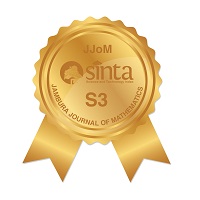The Comparison between Ordinal Logistic Regression and Random Forest Ordinal in Identifying the Factors Causing Diabetes Mellitus
Abstract
Keywords
Full Text:
PDFReferences
C. M. Ridhani, N. A. W. Putri, R. A. Fitriani, I. A. A. Rahmayati, and A. G. Rizka, "Analysis of trigger factors for diabetes based on CDC data" Jurnal Teknodik Pustekkom Kemdikbud, vol. 2022, pp. 1-7, 2022, doi: 10.13140/RG.2.2.14821.27362.
Y. Olviani and D. Novita, "Family support on blood sugar control compliance with diabetes mellitus patients during the covid-19 pandemic" Jurnal Keperawatan Suaka Insan (JKSI), vol. 7, no. 2, pp. 178-183, 2022.
A. Siahaan, E. I. Marpaung, and J. Pandaleke, "Tatalaksana geriatri dengan diabetes melitus" Jurnal Medik dan Rehabilitasi, vol. 4, no. 3, pp. 1-7, 2022.
R. Kemenkes, "Infodatin pusat data dan informasi kementerian kesehatan republik Indonesia" 2020, [Online] available at https://www.kemkes.go.id/downloads/resources/download/pusdatin/infodatin/Infodatin%202020%20Diabetes%20Melitus.pdf.
T. D. Cahyono and O. S. Purwanti, "Hubungan antara lama menderita diabetes dengan nilai ankle brachial index" Jurnal Berita Ilmu Keperawatan, vol. 12, no. 2, pp. 65-71, 2019, doi: 10.23917/bik.v12i2.9803.
R. Anggraini, "Korelasi kadar kolesterol dengan kejadian diabetes mellitus tipe 2 pada lakilaki" Medical and Health Science Journal, vol. 2, no. 2, pp. 55-60, 2018, doi: 10.33086/mhsj.v2i2.588.
I. D. G. I. P. Putra, I. A. P. Wirawati, and N. N. Mahartini, "Hubungan kadar gula darah dengan hipertensi pada pasien diabetes mellitus tipe 2 di rsup sanglah" Intisari Sains Medis, vol. 10, no. 3, pp. 797-800, 2019, doi: 10.15562/ism.v10i3.482.
Z. I. Nisa, A. M. Soleh, and H. Wijayanto, "Identifikasi faktor-faktor yang memengaruhi prestasi mahasiswa menggunakan regresi logistik ordinal dan random forest ordinal" Xplore: Journal of Statistics, vol. 10, no. 1, pp. 88-101, 2021, doi: 10.29244/xplore.v10i1.465.
L. B. C. Tanujaya, B. Susanto, and A. Saragih, "The comparison of logistic regression methods and random forest for spotify audio mode featurre classification" Indonesian Journal of Data and Science, vol. 1, no. 3, pp. 68-78, 2020, doi: 10.33096/ijodas.v1i3.16.
R. Susetyoko, W. Yuwono, E. Purwantini, and N. Ramadijanti, "Perbandingan metode random forest, regresi logistik, na¨Ä±ve bayes, dan multilayer perceptron pada klasifikasi uang kuliah tunggal (ukt)" Jurnal Infomedia, vol. 7, no. 1, pp. 8-16, 2022, doi: 10.30811/jim.v7i1.2916.
E. Y. Boateng and D. A. Abaye, "A review of the logistic regression model with emphasis on medical research" Journal of Data Analysis and Information Processing, vol. 07, no. 04, pp. 190-207, 2019, doi: 10.4236/jdaip.2019.74012.
T. J. Smith, D. A. Walker, and C. M. McKenna, "An exploration of link functions used in ordinal regression" Journal of Modern Applied Statistical Methods, vol. 18, no. 1, pp. 2-15, 2020, doi: 10.22237/jmasm/1556669640.
Y. Paliling, M. Fathurahman, and S. Wahyuningsih, "Multinomial logistic regression to model the combination of phdi status and hdi status of districts/cities in Kalimantan island" Jurnal Matematika, Statistika dan Komputasi, vol. 19, no. 3, pp. 460-472, 2023, doi: 10.20956/j.v19i3.22299.
N. I. Mardini, L. Marlena, and E. Azhar, "Regresi logistik pada model problem based learning berbantu software cabri 3d" Jurnal Mercumatika: Jurnal Penelitian Matematika dan Pendidikan Matematika, vol. 4, no. 1, pp. 47-53, 2019.
M. D´Ä±az-Perez, ´ Angel Carre ´ no-Ortega, J.-A. Salinas-And Ëœ ujar, and ´ Angel Jes ´ us Callej ´ on-Ferre, "Application of logistic regression models for the marketability of cucumber cultivars" Agronomy, vol. 9, no. 1, p. 17, 2019, doi: 10.3390/agronomy9010017.
V. Syrgkanis and M. Zampetakis, "Estimation and inference with trees and forests in high dimensions" in Proceedings of Machine Learning Research, 2020, p. 125.
Y.-X. He, S.-H. Lyu, and Y. Jiang, "Interpreting deep forest through feature contribution and mdi feature importance" arXiv preprint, 2023.
T. Y. Yuniarty, Erfiani, Indahwati, A. Fitrianto, and K. N. K., "Regresi ordinal logit dan probit pada faktor kesejahteraan rumah tangga petani tanaman pangan di provinsi sulawesi tenggara" Jurnal Statistika dan Aplikasinya, vol. 6, no. 2, pp. 313-325, 2022, doi: 10.21009/JSA.06216.
DOI: https://doi.org/10.34312/jjom.v5i2.20289
Copyright (c) 2023 Assyifa Lala Pratiwi Hamid, Anwar Fitrianto, Indahwati Indahwati, Erfiani Erfiani, Khusnia Nurul Khikmah

This work is licensed under a Creative Commons Attribution-NonCommercial 4.0 International License.
Jambura Journal of Mathematics has been indexed by
Jambura Journal of Mathematics (e-ISSN: 2656-1344) by Department of Mathematics Universitas Negeri Gorontalo is licensed under a Creative Commons Attribution-NonCommercial 4.0 International License. Powered by Public Knowledge Project OJS.
Editorial Office
Department of Mathematics, Faculty of Mathematics and Natural Science, Universitas Negeri Gorontalo
Jl. Prof. Dr. Ing. B. J. Habibie, Moutong, Tilongkabila, Kabupaten Bone Bolango, Gorontalo, Indonesia
Email: [email protected].



















